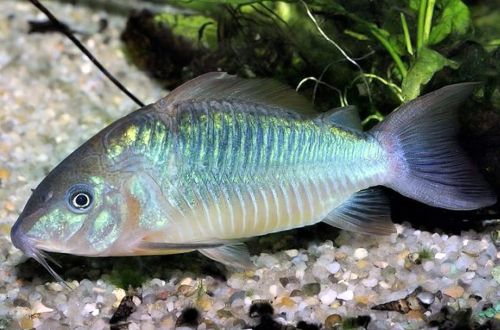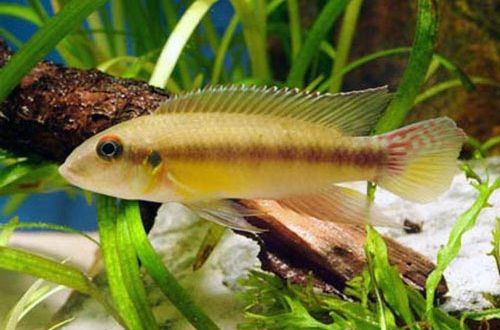
Brochis Bricki
Brochis Britski, Giant Corydoras or Giant Emerald Catfish, scientific name Corydoras britskii, belongs to the family Callichthyidae (Shell catfish). It got its name in honor of the Brazilian ichthyologist Heraldo Antonio Britski, who first discovered and described this species. Previously, until 2003, it belonged to the now defunct genus Brochis and, accordingly, had a different scientific name – Brochis britskii. It is still found in various sources and can be considered a synonym.

Contents
Habitat
Endemic to a small section of the Paraguay River (Spanish: Río Paraguay, port: Rio Paraguai) in the Brazilian state of Mato Grosso. It occurs in the area of numerous small tributaries, lakes and creeks in the upper reaches of the river.
Brief information:
- The volume of the aquarium – from 200 liters.
- Temperature – 20-26°C
- Value pH — 6.0–7.0
- Water hardness – soft (2-12 dGH)
- Substrate type – sandy
- Lighting – subdued or moderate
- Brackish water – no
- Water movement – light or moderate
- The size of the fish is up to 9 cm.
- Meals – any
- Temperament – peaceful
- Keeping in a group of 6-8 individuals
Description
Adult individuals reach a length of 8–9 cm. Outwardly, it resembles its close relative, the Emerald catfish, but is much larger and closer to another species, Brochis nosed, having the same elongated dorsal fin, stretching almost to the tail. Color shimmers from orange to emerald green depending on the light. At the mouth there are antennae, with which the catfish sorts through the ground in search of food. Sexual dimorphism is weakly expressed, it is extremely difficult for a non-specialist to distinguish a female from a female.
Food
Accepts all types of popular dry, frozen and live foods. The only important condition is that they must be sinking. A varied diet has a positive effect on the well-being of fish and their appearance.
Maintenance and care, arrangement of the aquarium
The optimal size of the tank for a small group of fish starts from 200 liters. The main emphasis is on the substrate, soft sandy soil or fine gravel should be used to minimize the risk of injury to the tendrils. It is recommended to organize several shelters in the form of snags or other decorative items. The rest of the design of the aquarium is not essential and adjusts to the needs of other fish, or the personal preferences of the aquarist.
Acceptable water conditions have slightly acidic pH values with low carbonate hardness, comfortable temperatures are in the range of 20–27°C. Sensitive to water quality, provide a productive filtration system, as well as regularly clean the substrate from organic waste and weekly replace part of the water (15-20% of the volume) with fresh water.
Behavior and Compatibility
Peaceful and sociable species, it is advisable to keep at least 6-8 individuals in a group. Compatible with many other popular aquarium fish. In addition, Brohis Britsky, thanks to his armor and considerable size, can get along with rather aggressive species.
Breeding / breeding
At the time of this writing, it was not possible to find reliable information about successful breeding experiments of the Giant emerald catfish in a home aquarium. For sale come from fish farms or, more rarely, are caught from the wild.
Fish diseases
The main cause of most diseases is unsuitable living conditions and poor-quality food. If the first symptoms are detected, you should check the water parameters and the presence of high concentrations of hazardous substances (ammonia, nitrites, nitrates, etc.), if necessary, bring the indicators back to normal and only then proceed with treatment. Read more about symptoms and treatments in the Aquarium Fish Diseases section.





